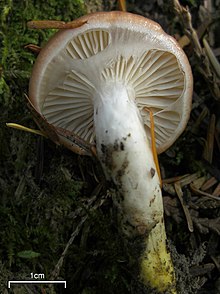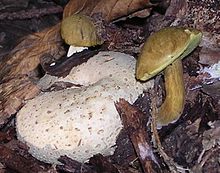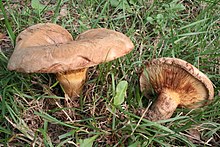Boletales
The order Boletales originally was created to describe boletes, but based on micromorphological and molecular phylogenetic characteristics, a large number of nonbolete species have recently been reclassified to belong to this group, as well.
[2] The order also includes some gilled mushrooms, in the families Gomphidiaceae, Serpulaceae, Tapinellaceae, Hygrophoropsidaceae, and Paxillaceae, which often have the same flesh texture as the boletes, spore-bearing tissue which is also easily separable from the cap, and similar microscopic characteristics of spores and cystidia.
Taxonomic studies using secondary metabolites and later molecular phylogenetic evidence moved several physically dissimilar groups into Boletales, including the Sclerodermataceae (earthballs) and the Rhizopogonaceae (false truffles).
[3] Similarly, the bolete genus Suillus is more closely related to the agarics and false truffles of Chroogomphus, Gomphidius, and Rhizopogon than to Boletus.
The genus Boletus contains many edible species, most notably, B. edulis, including B. aereus and B. pinophilus, though many others are eaten, as well, such as B. badius.
In North America, S. pungens, known also as the "slippery jack," is said by some to be delicious cooked, provided the slimy coat of its cap is removed beforehand.


